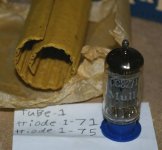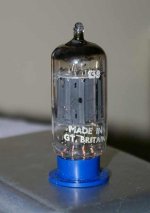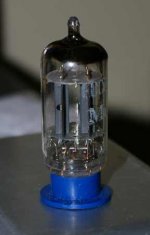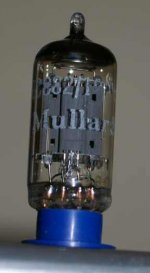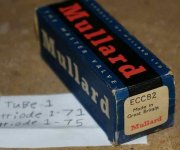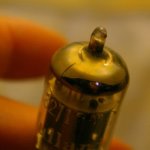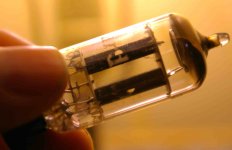I was thinking of auctioning this on Ebay,
but it occurred to me that someone here might have
an Octet (8) of Svetlana 6L6GCs to trade for it.
Best price I've found for SV 6L6s seems to be about $25,
but you guys probably cut far better deals on them than I can find.
Anyway, I'm not collecting Mullards anymore;
I'm trying to build some guitar amps.
Maybe 10 EL34s JJ would be as good, I don't know.
This was given to me 'NIB', with original wrappings,
but its been out for testing several times anyway.
one triode tests 71 the other 75 on my CanArmy Tube Tester.
Because its NOS and long-plates date from the late 50s,
I can't offer any warrantees as to how many hours it may last,
or its suitability for any particular circuit.
but it occurred to me that someone here might have
an Octet (8) of Svetlana 6L6GCs to trade for it.
Best price I've found for SV 6L6s seems to be about $25,
but you guys probably cut far better deals on them than I can find.
Anyway, I'm not collecting Mullards anymore;
I'm trying to build some guitar amps.
Maybe 10 EL34s JJ would be as good, I don't know.
This was given to me 'NIB', with original wrappings,
but its been out for testing several times anyway.
one triode tests 71 the other 75 on my CanArmy Tube Tester.
Because its NOS and long-plates date from the late 50s,
I can't offer any warrantees as to how many hours it may last,
or its suitability for any particular circuit.
Attachments
Last edited:
Are you sure that is a genuine Mullard? The print does not look like any Mullard I have seen before. The box and the wrapping look genuine, though. What is the etch code? Does it have seams on the top of the glass?
There are four seams on the top-glass (like the stars on a compass).
The 'Blackburne' code on this one is
261 B8C (one brown etch over the other). (or possibly k61...these are hard to see even in good light)
This code usually indicates the plate-type,
and/or the inner component style/issue.
The getters are dual-supported circles.
There is a circle and a seriffed 'C' (reversed) on the bottom,
which is 'bathroom etched' rough glass (the C is actually raised casted).
The 'Made in Great Britain' lot number (above) is 163.
(this is always a separate screening from the Mullard logo/name)
And yes,the boxes are also real,
and the boxes alone are worth $50 a set (including wrappings),
both to collectors and fraudulent dealers.
The inner long-plates can't be faked, or any other internals.
(If you can do that, you might as well make brand-new Mullards!).
Typical fakes are either Japanese or Chinese (sometimes Russian or Telefunken) which have been 'silkscreened'.
The story with 8CC82s is very similar.[FONT=Arial, Helvetica, sans-serif][FONT=Arial, Helvetica, sans-serif] the former Ebay page:
[/FONT]The Tubeking's Guide to NOS and Vintage Audio Tubes[FONT=Arial, Helvetica, sans-serif]
which is still available on Google in Archived pages.
Here's a quote:
"[/FONT]However, you should know which Mullard ECC83 type you are getting, because the sound can differ significantly between each type.
MC1 Long Plate Square Getter: The most sought after, early production and expensive Mullard ECC83 from the mid-1950s. This one has 17mm long gray ladder plates and a dual supported square getter. This is the ultimate 'Mullard' sound.... big, open and warm with a tweedy harmonic overdrive. The etched MC1 code on the bottom of the glass denotes this type, along with the 'B' Blackburn Code + a Number and a Letter.
F91 Long Plate Dual Halo Getter: Similar in sonic characteristics to the MC1 Mullard above. This version comes from the late 50's (roughly 1957-1958) and will sometimes come with a square getter. It sounds very similar or the same to the MC1 Mullard, but is usually a bit less expensive. You can tell this type by the etched F91 code on the bottom of the glass, along with the 'B' Blackburn Code + a Number and a Letter.
F92 Long Plate Single Halo Getter: Similar in sonic characteristics to the F91 Mullard above. This version comes from the late 50's (1959) and will have a single supported halo. It sounds very similar or the same to the MC1 Mullard, but is usually somewhat less expensive. You can tell this type by the etched F92 code on the bottom of the glass, along with the 'B' Blackburn Code + a Number and a Letter.
I61 Short Plate Halo Getter: This is the first short plate Mullard ever produced and was made around 1959-1964. A great tube with that classic 'Mullard' sound, this tube has the benefit of resistance to microphonics due to the plate structure. At the same time, the open 3-D midrange sounds similar to the long plate Mullards, with a little more balls. One of my favorite guitar tubes. You can tell this type by the etched I6I code on the bottom of the glass, along with the 'B' Blackburn Code + two Numbers and one Letter.
I63 Short Plate Halo Getter: This is the second short plate Mullard ever produced* and was made from 1965 onwards. This tube is a bit more compressed than some of the Mullards listed above, so it is favored by many rock guitarists for its distortion characteristics. Many people will use an I61 or F91/F92 tube in the V1 (first slot) of their guitar amp for overall sound, and then put an I63 type in their overdrive slot (usually V2 or V3). This can be an ideal combination, depending on your amp and what you are going for. You can tell this type by the etched I63 code on the bottom of the glass, along with the 'B' Blackburn Code + two Numbers and one Letter. *(There was actually a very short production run "Yellow Label" Mullard ECC83 produced right before this tube.)
CV4004 M187 ECC83 Box plate: The CV4004 box plate Mullard is a military production tube that can be identified by its unique plate structure. This is a well built, highly desirable and favored tube by audiophiles. Many swear by this tube for their home tube stereo systems, and prefer them to regular Mullards. Some guitarists use them in their amps, but most seem to prefer regular Mullards. Produced at the Mullard Mitchum Factory these tubes can usually be identified by the 'R' code etched in the bottom of the glass + a Number and a Letter.
Mullard 10M Master Series ECC83: These were specially made, later production Mullard short plates that are rated for 10,000+ hours in a tube amp. They were also specially selected for low noise and balanced triodes. They can be identified by the Gold Mullard '10M' Logo on the tube and they have gold or regular pins. The Gold Pin versions are superior and worth more. These tubes are highly sought after by audiophiles. They have a wide-band sound similar to a Telefunken, but with a touch of that Mullard warmth. They are quite rare, and can fetch insane prices, especially if they are NOS. I finally got a chance to hear this tube in my guitar amp and I am impressed... fabulous balanced clean sound with a touch of brightness.... incredibly SWEET. Overdrive was pretty cool as well. I can see why audio guys go crazy for these tubes.
There are other Mullard ECC83s that were produced later, but the tubes listed above are the ones you should look for. Beware of fake Mullards being sold on ebay. These will often have 'perfect' baked-on enamel labels that will not wipe off. These labels usually look too thick and 'painted-on' in pictures. Real silk-screened Mullard logos look much more delicate in pictures. Sometimes Matshushita tubes will be sold as Mullards with Shield logos. These are Japanese tubes that were made on Mullard tooling so they look similar to I63 Type Mullards. Not a bad tube, but be aware that some vendors will relabel these to pass them off as the real thing. Sometimes you will see "OEM" Mullards that originally had no labels branded with a fake Mullard label from another era. This can also happen with British 'Brimars' which can have fake Mullard labels. There are also people on ebay selling 'Mullards' with obviously new, fake and cloned 'Mullard' boxes that look nothing like the real thing.... unbelievable. Always purchase your tubes from reputable dealers. We carefully screen each and every tube we sell to make sure they are authentic."
[/FONT]
Last edited:
Convincing fakes can also be detected:
In this picture, you can see full circles especially on left here
(completed on the inside of plate) on the Mazda fakes.
Real Mullards (like the one I'm selling),
only have half-circles. The INNER half of the circular hole in the plate is missing, as it should be.
Also, fake Mullards (i.e., Mazda)
will have double-stitched lines on tube top:
In this picture, you can see full circles especially on left here
(completed on the inside of plate) on the Mazda fakes.
An externally hosted image should be here but it was not working when we last tested it.
Real Mullards (like the one I'm selling),
only have half-circles. The INNER half of the circular hole in the plate is missing, as it should be.
Also, fake Mullards (i.e., Mazda)
will have double-stitched lines on tube top:
An externally hosted image should be here but it was not working when we last tested it.
Hi Nazroo, Ive got a couple these, what do you think they are worth?
I sold my last pair of ECC83s for about $250.00 AM,
which most people thought was low, and the buyer (bidder)
thought was a bargain.
I wasn't out to gouge anyone or make a lot of money.
I just wanted to pass them on to someone who knew what they were.
k61 would be an ECC82. 261 may not be a valid code.
I have never seen a genuine Mazda with a seam on top. Seams usually mean Philips equipment, but not necessarily in a Philips factory (e.g. Ei Serbia, BEL India, some Matsushita?).
The ladder anode shape was used by lots of makers. Your valve could be genuine, but it is unlikely to have received its external printing in a Mullard factory. Curious, as the external print is the easiest part for fakers to get right. Maybe, inverting the logic, the dodgy-looking print is a sign of genuineness because only a really incompetent faker would do this?
If I had to guess, I would say this one came from BEL as they were often a bit random with marking. For some reason a late valve has ended up in an early box.
I have never seen a genuine Mazda with a seam on top. Seams usually mean Philips equipment, but not necessarily in a Philips factory (e.g. Ei Serbia, BEL India, some Matsushita?).
The ladder anode shape was used by lots of makers. Your valve could be genuine, but it is unlikely to have received its external printing in a Mullard factory. Curious, as the external print is the easiest part for fakers to get right. Maybe, inverting the logic, the dodgy-looking print is a sign of genuineness because only a really incompetent faker would do this?
If I had to guess, I would say this one came from BEL as they were often a bit random with marking. For some reason a late valve has ended up in an early box.
In fact, all the early Mulls were 'dodgy' in their silkscreening.
The two 83s I sold were both silkscreened twice:
Once at the factory ("Mullard" , "ECC83" etc.)
white, but diluted almost 2%-milky dull and nearly see-thru.
Once presumably after inspection/sorting
'Made in Great Britain' (etc.)
This was with a brighter/thicker white, and without careful orientation:
On one tube this was on same side as Mullard labelling,
on the other it was the opposite, and was done probably accidentally,
since the silkscreening was where the 'ECC83' should have been,
but that had been wiped off while still wet,
presumably at the factory by a careless silkscreener.
This led the second printer to place his (G.B.) on the wrong side.
I believe there is great variance in the first printings,
because of the year and/or assigned laborer supposed to do it.
I believe the even greater variance in the "Made G.B." printings
is because these were done later after testing, sorting and shipping,
when they may have been done in different locations,
even from the same batches, after they were distributed and warehoused.
This would be because of 'new' regulations on marking origin of product, which was not carried out consistently
(because it wasn't enforced).
The two 83s I sold were both silkscreened twice:
Once at the factory ("Mullard" , "ECC83" etc.)
white, but diluted almost 2%-milky dull and nearly see-thru.
Once presumably after inspection/sorting
'Made in Great Britain' (etc.)
This was with a brighter/thicker white, and without careful orientation:
On one tube this was on same side as Mullard labelling,
on the other it was the opposite, and was done probably accidentally,
since the silkscreening was where the 'ECC83' should have been,
but that had been wiped off while still wet,
presumably at the factory by a careless silkscreener.
This led the second printer to place his (G.B.) on the wrong side.
I believe there is great variance in the first printings,
because of the year and/or assigned laborer supposed to do it.
I believe the even greater variance in the "Made G.B." printings
is because these were done later after testing, sorting and shipping,
when they may have been done in different locations,
even from the same batches, after they were distributed and warehoused.
This would be because of 'new' regulations on marking origin of product, which was not carried out consistently
(because it wasn't enforced).
Last edited:
Here's a close up of my tube:
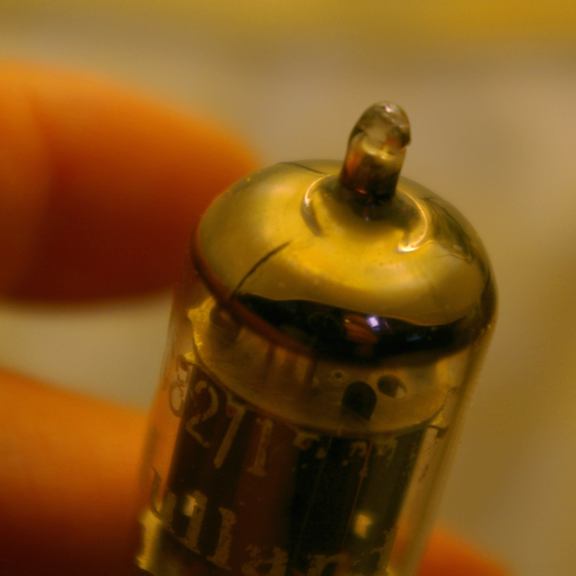
The top is clearly the authentic Mullard pattern,
not the overdone crimping of the fakes. (see above, again.)
Also, note the HALF-moon hole in the long-plate,
showing that the tube is both authentic and OLDER stock,
contrary to your assertion above.

Older tube is in older box, because they came together.
For more information on fake Mullards, go here:
Vintage Amps.com
http://www.vintageamps.com/plexiboard/viewtopic.php?f=13&t=27468

The top is clearly the authentic Mullard pattern,
not the overdone crimping of the fakes. (see above, again.)
Also, note the HALF-moon hole in the long-plate,
showing that the tube is both authentic and OLDER stock,
contrary to your assertion above.

Older tube is in older box, because they came together.
For more information on fake Mullards, go here:
Vintage Amps.com
http://www.vintageamps.com/plexiboard/viewtopic.php?f=13&t=27468
Attachments
Last edited:
A valve made using Philips equipment could be identical internally to one made in a Philips factory, including anode hole shapes. The 'Mazda fake' you show on the left of your picture in post 5 is unlikely to be made by Mazda, as they did not have top seams. It could be that the Mullard markings on it were put there by Mullard - they sometimes bought in valves from elsewhere but still marked them as Made in Britain.
So my conclusion is that your 'genuine' valve may or may not be genuine, and your 'fake' may or may not be fake. I am astonished to hear that someone might be willing to pay $50 for a genuine Mullard box. I am richer than I thought!
So my conclusion is that your 'genuine' valve may or may not be genuine, and your 'fake' may or may not be fake. I am astonished to hear that someone might be willing to pay $50 for a genuine Mullard box. I am richer than I thought!
One would do well also to heed this posting:
The Double-Supported Getter is neither 'inside' nor 'outside' the getter circle.
In fact, a single bar rises, bends at a right angle, and bends again to go down to the plate. The Getter is welded ON TOP of the double-support style Getter.
This is the trademark of the EARLY Mullards (i.e., 1957-1960s), and no fake 'Mullard' of any kind has surfaced that mimicks this difficult and rarely noticed feature.
Finally, Another person has observed that Mullard and Philips indeed swapped part-inserts, as these are the 'expensive' and difficult to manufacture component, which requires skilled labour to assemble, and also the typical problem with all runs was guessing (or second-guessing) demand. Both Mullard and Philips were often inaccurate as to adequate run-sizes and internal part-sourcing (such as semi-precious metals).
Contrary to what one may think, part-swapping ensured consistency and quality for both companies, rather than ad-hoc hiring of temporary workers which would have required special training, and given mixed results.
'Crew-lending' is still a common modern practice.
The double-getter supports also authenticate my tubes as Mullard (made in the Blackburn plant), and early.
A Final Observation on the Getter Supports.Re: *****Fake Mullard Advisery*****
An externally hosted image should be here but it was not working when we last tested it.by johnnysavant on Thu Apr 28, 2005 3:59 pm
Thanx, TubeGetter for your insights. After some empirical testing with several dozen tubes (83s, 82s, and 81s), I have to take issue with a couple things, your expertise not withstanding.
I checked a whole bunch of tubes I know to be real Mullards and found:
1) Generally, the single seam line holds true MOST of time, but not all. I have a few that are cross-hatched BUT, the second seam is much fainter. I also checked my Holland Bugle Boys. They are all cross-hatched exactly like the MIJ Matsus, but I'm sure everyone knows that already.
2) The semi-circle in the plate of ALL my Mullards and Bugle Boys is exactly as you describe. Not one of my tubes deviates from this.
3) Most of my single-support Mullard halos have the outside weld, but a couple have inside welds, yet have single seams and the proper semi-circle in the plates. I also have a couple of with double support getters that are welded on the inside.
From these observations, I conclude that the only reliable indicator is the semi-circle configuration. For all the tubes I checked, this was consistently true 100% of the time. A Mullard (or Bugle Boy) will not have the semi circle on the inside of the plate. Some of the other characteristics may generally be true, but not 100% foolproof. I bring this up in case someone is tempted to trash, sell or trade away a good tube because it doesn't meet ALL of the criteria. Based on my testing, if it meets the semi-circle test, it's the real deal.
But I would like to hear from others who happen to own a whole bunch of Mullards and other Phillips dual triodes.
One more observation. ALL of my Mullards with mid-60s date codes do indeed meet ALL of the criteria to the letter. The deviants are from later runs.
The Double-Supported Getter is neither 'inside' nor 'outside' the getter circle.
In fact, a single bar rises, bends at a right angle, and bends again to go down to the plate. The Getter is welded ON TOP of the double-support style Getter.
This is the trademark of the EARLY Mullards (i.e., 1957-1960s), and no fake 'Mullard' of any kind has surfaced that mimicks this difficult and rarely noticed feature.
Finally, Another person has observed that Mullard and Philips indeed swapped part-inserts, as these are the 'expensive' and difficult to manufacture component, which requires skilled labour to assemble, and also the typical problem with all runs was guessing (or second-guessing) demand. Both Mullard and Philips were often inaccurate as to adequate run-sizes and internal part-sourcing (such as semi-precious metals).
Contrary to what one may think, part-swapping ensured consistency and quality for both companies, rather than ad-hoc hiring of temporary workers which would have required special training, and given mixed results.
'Crew-lending' is still a common modern practice.
The double-getter supports also authenticate my tubes as Mullard (made in the Blackburn plant), and early.
I am richer than I thought!
you are indeed, if you have mistaken real Mullards in the past as fakes,
and still kept them.
I'd say if you have to guess, you don't know what you're doing.If I had to guess, ...
God knows there's plenty of paranoia in regard to tubes, and tube-fakes.
But as many have pointed out,
the real world is much less exciting than the James Bond version.
There are lots of tubes that people have only imagined were 'fakes'.
The sharing of part-sourcing and stock between Philips and Mullard is a great example.
Real tubes aren't serial-numbered or provided with accompanying diplomas of dedigree,
like inbred horses or dogs (and its likely that more pedigrees have been faked than tubes...)
What makes a good Mullard in the first place is trained assemblers, quality material sourcing,
and consistent testing standards. Those were all in place when Philips and Mullard cooperated,
and exchanged shelf-components and stock to fill demand orders.
A Mullard with innards supplied by Philips is not a 'fake',
nor is a Philips with innards supplied by Mullard.
nor is even a Mullard rebranded for Philips or Amperex.
If you think the Blackburn plant produced higher quality than the Philips plant,
you are mistaken. What makes quality is standards and testing.
The same quality-control standards were used by both companies,
and the same technology was behind both the manufacture and the testing.
A 'collector' may rightly insist in only purchasing Blackburn tubes,
or pre-1965 stock, or both, but he has no business telling those
who buy them to actually use them that such a fetish is scientifically based.
Such 'lore' belongs instead to the art-gallery and the subjectivism of speculating on 'futures' in antiques.
Last edited:
I guess the big question is what is a Mullard? Does it have to be made in Blackburn (or Mitcham etc.)? Could it have been made in Holland, using identical parts, machinery and techniques? Or India? Could it have been bought in from RFT and then marked by Mullard and put in a Mullard box (like some EL34 were). I have Mazdas marked as Mullard and vice versa, yet these are not fakes as the marking was done by or for the company concerned. Is a Tungsram made in Blackburn really a Mullard in disguise (yet apparently still cheaper)?
We must be careful about circular logic: "Genuine Mullards always have feature X", "I know it is genuine because it has feature X" - yet without any original evidence confirming that feature X was always used by Mullard and never by anyone else. Most of the people who made these valves are now retired (or dead), and documentation is either lost or unobtainable (possibly hidden away in some vast Philips archive store?).
We must be careful about circular logic: "Genuine Mullards always have feature X", "I know it is genuine because it has feature X" - yet without any original evidence confirming that feature X was always used by Mullard and never by anyone else. Most of the people who made these valves are now retired (or dead), and documentation is either lost or unobtainable (possibly hidden away in some vast Philips archive store?).
Well this is all great, but muddies the waters.
My ECC82 is simply a real Mullard, made in Britain in the Blackburn factory, prior to 1965.
It has all the features, both required and desired, and expected.
Mystery solved.
I can't speak for other ECC82s out there, but mine's not only 'legal',
and 'technically' a Mullard; its the one people want.
My ECC82 is simply a real Mullard, made in Britain in the Blackburn factory, prior to 1965.
It has all the features, both required and desired, and expected.
Mystery solved.
I can't speak for other ECC82s out there, but mine's not only 'legal',
and 'technically' a Mullard; its the one people want.

Last edited:
I sold my last pair of ECC83s for about $250.00 AM,
which most people thought was low, and the buyer (bidder)
thought was a bargain.
I wasn't out to gouge anyone or make a lot of money.
I just wanted to pass them on to someone who knew what they were.
Wow, I had no idea, I paid 10 dollars for the pair, still never used them.
The cheapest way to buy 'Mullards', if you really want them, is to find Blackburn-made valves carrying other brand markings. For some reason, some people will pay more if it says Mullard on the outside (even when it isn't Mullard on the inside) and less if it doesn't (even if it is Mullard on the inside).
- Status
- This old topic is closed. If you want to reopen this topic, contact a moderator using the "Report Post" button.
- Home
- Design & Build
- Parts
- Mullard ECC82 (12AU7) for trade or sale
